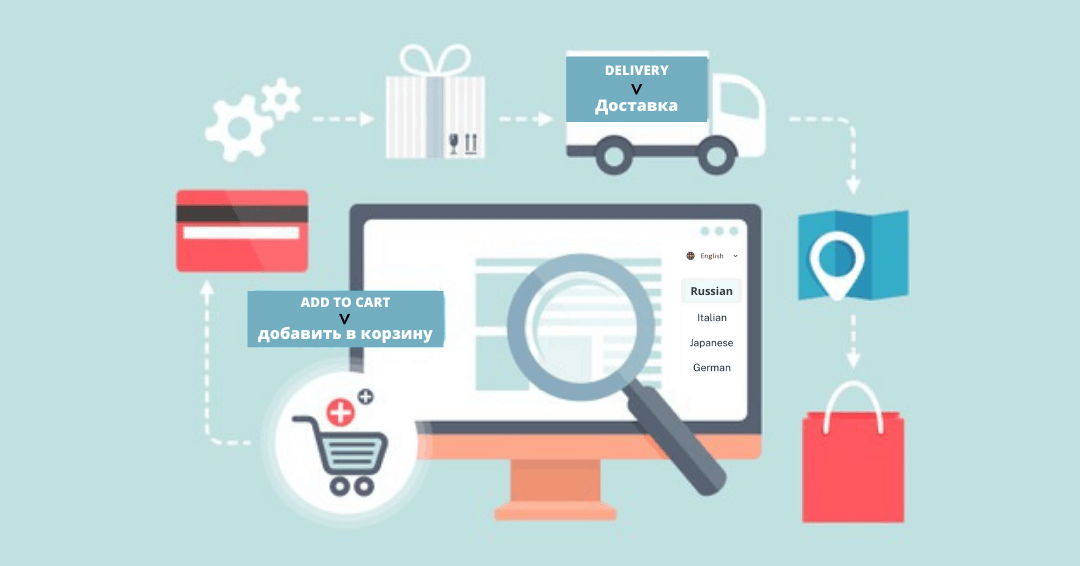Are you looking for Russian eCommerce translation and localization services for your online business?
Good choice! Russia is among the fastest-growing economies in the world and in the top 5 of the largest economies in Europe.
As a result of the constantly growing Russian middle class and increasing internet penetration, the demand for consumer products steadily increases which in turn offers a great opportunity for any business to expand.
The constantly growing eCommerce is a distinctive niche in the Russian market which could turn out to be your train to success!
However, before moving your business to Russia, you should read our blog about what you need to consider before localizing and translating your eCommerce website for Russia.
1. Understand the market
General Economic Overview of Russia
Despite the current events, expanding your business to Russia might still be a lucrative opportunity for you and your business.
With 146 million people Russia has the 9th largest population in the world.
Moreover, there are approximately 106 million internet users and nearly 65 million online shoppers
What’s more, these numbers are expected to continue to grow, especially these of online consumers in Moscow and St Petersburg, which are the biggest cities in the Russian Federation.
Moreover, the GDP is constantly growing. According to Rosstat (Russian Statistics), the GDP has grown by nearly 50% between 2011 – 2016.
Have a look at the diagram below which shows this trend of the GDP growth in billion rubles:


In terms of age groups, Russia is not an exception to the general trend – the older the age, the lower the online shopping activity. According to a recent study, people between 18 and 35 tend to shop online more than people above 36 years of age.
Undoubtedly, the current statistics are really promising. Nevertheless, the prognosis for the future will not disappoint you either! Here are some statistics to keep in mind:
- Internet penetration in Russia is at 80%.
- smartphone penetration is nearly 70%.
- eCommerce is expected to grow by 170%
- By 2023 the Russian e-commerce will be worth over 45 billion Euros.
Also Read: 7 Common Russian Translation Mistakes and How to Avoid Them
Russian eCommerce Overview and Trends
Still, you should keep calm because there are a few more things that need to be cleared up especially if you are a B2C company.
- Russian has no leading e-commerce platform such as Amazon (US) or Tmall (China). The good news is things are constantly changing and currently several platforms are trying to fill this gap in the market. One of them is Alibaba together with Mail.ru.
- High logistics costs. Russia is not nearly as densely populated as countries in Europe, for instance. As a result, delivery costs are higher. Also, the delivery takes a longer time.
- Paying in cash as a preferred payment method. Don’t get discouraged, though, because studies show that online payments as popular as card payment in physical shops.
2. Get to know your customers
If you want to successfully sell your products in Russia, you should be aware of the online shopping habits of your future customers. Have a look at the diagram below:

From this diagram, you could clearly see that Russian customers have a strong preference for distinct categories such as electronics and clothing.
In terms of fashion, Russian customers follow European fashion trends and regard them as an essential sign of status.
As for food & drinks, the low percentages could be explained by the fact that online shopping is not the most convenient option due to longer delivery times.
It is important to highlight that Russian customers are very sensitive when it comes to the value they get for their money.
The assumption that Russian brands are less expensive than overseas’ is quite widespread.
This is why Russian customers usually prefer to invest in Russian brands.
Thus, in order to successfully integrate your business into the Russian market make sure that you offer quality products at a reasonable price!
Connect With Russian Customers In Their Native Languages.
Milestone helps you seamlessly translate content & localize your website, products, and services for more reach, better conversions, and greater sales.
3. Russian eCommerce Translation
Russians really value their language, so translating your content in Russian will really flatter your Russian customers.
A study by Russiyskaya Gazeta shows that the Russian population is not big on foreign languages. Have a look:
- Only 30% can speak English
- 7% can speak German
- 1% can speak French
- 1% can speak Spanish
These numbers should have already convinced you how important is to localize your content in Russian.
Otherwise, you will hardly be able to reach and connect with the Russian buyer.
An important part of the localization process is translating your content and when it comes to Russian, this could be quite a challenge.
However, with proper planning, you could successfully do the job!
Also Read: 10 Facts You Never Knew About the Russian Language
Here are some aspects to consider for Russian eCommerce translation:
- Text expansion up to 300%. Although German is much worse, Russian is one of these languages with long words –according to Wikipedia the longest Russian word is 35 letters.
Make sure your text boxes, menus, and buttons can accommodate longer words.

- Be aware of the different encoding. Make sure you are familiar with the Cyrillic script encoding if you want to display your localized text correctly.
- Avoid placeholders at all costs! The Russian language has a different verb form for each gender (neutral, masculine, and feminine). So strings such as [User] said wouldn’t work well in Russian.
4. Adapt your design

To successfully connect with Russian buyers, you need to go beyond just Russian ecommerce translation. You have to localize your images, symbols and colours.
In Russian culture, there are quite a few symbols, icons, and colors that carry a special cultural meaning. To ensure a successful localization process it is imperative to adapt your content and design according to the Russian beliefs.
Symbols
- When pointing at something don’t use a single finger since it is considered rude. Instead, extend your arm.
- Don’t shake hands with your Cut resistant gloves on – it is considered rude. Also, don’t shake hands across a threshold – it will bring you bad luck!
- Be humble. Bragging and boasting are not tolerated in Russia and is even believed to bring bad luck.
- Don’t use images of flowers if they are an even number – even numbers of flowers are used only for funerals.
- Russian are very religious people, so make sure you don’t disrespect their religion. Also, keep in mind they are Orthodox, and thus, their customs and beliefs might differ from Catholicism’s
Colors
When it comes to colors, you could use some in your favor such as orange, which is associate with creativity, and yellow – with hope.
However, make sure to stay away from red, which is usually identified with the Bolsheviks and the communists, and blue which is often related to sadness or depression.
Also read: How to Localize Your App and Reach New Users
5. Devise the right marketing strategy

Your eCommerce marketing strategy is as important as any other aspect of the localization process.
The following points cover the most crucial point of your marketing approach to the Russian market.
- Register a local Russian domain. The most popular one is .ru, but you could also use .com, .net, .org, .info or .biz. Also, you could add .ru before or after any of these variations.
- Have a Cyrillic domain. Since 2001 it is allowed to have a Cyrillic domain in Russia, so if want to increase your brand’s local recognition you might as well make a Cyrillic domain as well.
- Use Yandex, not Google. Promote your domains through the local search engine Yandex, not Google. Submit your sitemaps for crawling to Yandex, Yahoo, and Google.
- Devise a multidimensional SEM campaign. On one hand, you could invest in PPC (pay-per-click) campaigns on popular Russian websites to familiarize the customers with your brand. In addition, select keywords in Russian and even in other languages to ensure your products can be found easily.
- Localize your creatives and videos. Make sure to translate and localize your images, videos, and ads in Russian
- Russian customer support. Make your FAQs, policies, and customer support available in Russian to provide a seamless customer experience
Russia is a huge and diverse market that offers great opportunities for the future development of your online business.
Nevertheless, the Russian market has its challenges and special characteristics.
This, however, should not discourage you! With a well-devised localization strategy, you can successfully expand your online store in Russia.
We can help you with expert Russian eCommerce translation and localization.
Get in touch with us to know about our custom language solutions.
Connect With Russian Customers In Their Native Languages.
Milestone helps you seamlessly translate content & localize your website, products, and services for more reach, better conversions, and greater sales.




